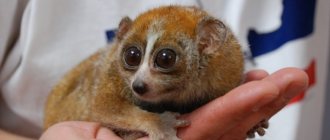One of the most interesting and unusual animals on our planet is the lemur. Surely, most people immediately imagine the cute big-eyed animals from the cartoon “Madagascar”. Indeed, this is exactly what some of the many species of these funny animals look like.
Scientists know about more than 100 species of lemurs. They differ not only in color and size, but also in their lifestyle, food preferences and character.
general characteristics
Lemurs (Lemuriformes) from the order of mammals are endemic inhabitants of Madagascar and Comoros.
Lemurs are so diverse that at first after their discovery they were considered completely different species. The smallest representatives of the mouse lemur species grow no more than 10 cm in length and weigh no more than 49 g. The largest lemurs are indies; adult individuals of this species can weigh about 10 kg. There is evidence that prehistoric lemurs could weigh from 100 to 150 kg and reached the size of an adult gorilla. Unfortunately, the ancestors of modern lemur-like creatures disappeared forever from the face of the Earth. But, despite the differences, representatives of lemur-like animals also have common features. The shape of the head in most species resembles a “fox” muzzle, tapered towards the nose. The bodies of lemurs are elongated, flexible and strong.
The eyes are located not on the sides, but in the front, due to which lemurs have a very unusual and slightly surprised appearance. Eye size depends on lifestyle.
Crepuscular and nocturnal representatives of the species have large, round eyes, while diurnal animals have less pronounced eyes. Eye color can be brown, yellow, orange-red. Among other species, there are blue-eyed animals. Black lemurs have a unique iris color.
All lemur-like animals have well-developed limbs and a long tail, which helps animals stay in trees and serves as a balancer when jumping from branch to branch and while moving on the ground. The only short-tailed species of lemur is the indi, their tail is only 5 cm long. The limbs are five-fingered, on the front paws the fifth finger is opposed to four. Thanks to this, lemurs tenaciously hold on to branches, can pick up objects in their paws and hold food.
All representatives of the species have nails growing on their fingers, except for the second finger on the lower limb. The “toilet” toe on the foot is equipped with a claw, which animals use for hygienic purposes.
The Madagascar lemur is the only species of lemur that has claws on the fingers of the forelimbs, and nails on the hind limbs.
The body of the animals is covered with thick fur, which is colored depending on the type of animal. In the wild, black and white, black, brown, gray, red and red-red colors are found.
Elena
Ask a Question
Question to the expert
How do lemurs sleep?
Lemurs spend almost all their time in trees. Accordingly, animals sleep on the branches in convenient forks. Some species prefer to sleep in tree hollows. Sometimes entire families from 5 to 15 individuals are located in spacious hollows.
Nutrition
Sifakas are vegetarians. The diet is based on plant foods, consisting of twigs, leaves, flowers, bark, and buds. Fruits and various fruits are a delicacy for them. If food needs to be picked up from the ground, the lemur bends down and grabs it with its mouth, or less often picks it up with its limbs.
The search for food begins in the morning, the animals move at the average height of the trees and travel from 400 to 700 m. The group is always led by a dominant female. A tropical downpour can confuse plans and force the monkeys to take cover for a while.
Despite the abundance of food in the forests, primates are not averse to visiting people to get additional treats in the form of cultivated fruits, rice and legumes. Sifaka is loved for its gullibility and is sometimes tamed.
Sifaka lemurs eat only plant foods
Common types
Until 2008, only 31 species of lemurs were known, but now there are more than 100 species, grouped into five families. Scientists do not stop research and search, so the number of species is still not final.
Family Daubentoniidae
This family consists of one species of lemur. The Madagascar bat has unique differences from other similar animals, so representatives of the species are separated into a separate family.
Initially, nocturnal bats or aye-ayes were assigned to the rodent order due to the structure of their teeth. But during the study, scientists found many similarities with lemur-like animals.
Madagascar bat (Daubentonia madagascariensis)
The little bat is considered the largest nocturnal species on the islands. Individuals of this species spend most of their lives in trees and descend to the ground on very rare occasions. The body length of an adult is 32–44 cm, the tail is quite long from 42 to 48 cm, the weight of the arms rarely exceeds 1.9–2.4 kg. The body of the animals is covered with wool with a dense, soft undercoat. Color black or brown-black.
The head is round, the muzzle is short and wide. The little arms have large nocturnal eyes and large sensitive ears. The color of the iris is orange-yellow.
The front legs are slightly shorter than the hind legs, and the toes end in sharp claws. The middle fingers are much longer than the others; with their help, lemurs extract insects from under the bark of plants. Unlike other lemurs, the fifth toes on the front legs are not opposable. Nails grow on the toes of the hind paws.
Family of dwarf lemurs (Cheirogaleidae)
This large family includes five genera, which consist of 33 species of dwarf lemurs. The average body length of animals does not exceed 13–23 cm, the weight of adults is from 22 to 530 g.
Dwarf mouse lemur (Microcebus myoxinus)
These representatives of the dwarf family are rightfully recognized as the smallest among all lemurs. The total body length of an adult is no more than 17–24 cm. Body weight does not exceed 50 g. The tail of the animal is half of the total body size, thickened at the base and covered with soft hairs. The upper part of the animal's body is covered with soft red-brown fur, the lower part is creamy white.
The head is small with a short muzzle. The eyes are large, surrounded by a rim of black wool and very expressive. The ears are quite large and mobile; there is practically no hair on the ears.
Mouse lemurs are active at night and at dusk. During cold periods, animals of this species hibernate.
Rat lemur (Cheirogaleus major)
Another name for the species is rat maqui. Small animals are from 20 to 26 cm, weight is about 140–370 g. The tail is quite long compared to the body, from 20 to 29 cm. The body of the animals is covered with gray or red-brown fur, in the area of the sacrum the fur is lighter. The ears are large and almost bare. The eyes are expressive and large.
Family of lepilemurid lemurs (Lepilemuridae)
The slender-bodied family unites animals whose size does not exceed 32 cm from nose to sacrum. The weight of sexually mature individuals is from 1 to 1.3 kg. There are 26 species in the group that are active at night and twilight. All members of the family live in trees and rarely descend to the ground.
Northern slender-bodied lemur (Lepilemur septentrionalis)
Northern lemurs are small animals, the body length of which does not exceed 33 cm, the tail from 21 to 26 cm. The weight of mature individuals is from 710 to 820 g. Thin-bodied lemurs have small ears, the body is covered with grayish-brown fur, along the back from head to tail there is a dark stripe.
Small-toothed lemur (Lepilemur microdon)
The body length of mature small-toothed lemurs is from 22 to 32 cm. The size of the tail is approximately equal to the length of the body. The upper part of the body is red-brown, with a dark stripe located from the head to the base of the tail. Small-toothed lemurs do not gather in groups and prefer a solitary existence.
Lemur family (Lemuridae)
This is perhaps the most popular and numerous family of lemurs on all the islands. Lemurs are active both at night and during the day; moreover, these animals, unlike other subspecies, often descend to the surface of the earth. The family consists of five genera, which unite 21 species.
Ring-tailed lemur (Lemur catta)
Another name for the species is ring-tailed. This is the most popular species of lemur, which became famous thanks to the cartoon “Madagascar”. The size of the animals is from 34 to 52 cm, the tail is from 57 to 63 cm, and the weight is from 2.1 to 3.7 kg. Ring-tailed cattas are diurnal animals that gather in groups of 25–35.
A distinctive feature of the species is its luxurious tail with black and white stripes. The tail not only serves as a balancer during movement, but also plays an important role during animal communication. For example, during the fight for territory, adult males smear the hairs on their tail with a sharp-smelling secretion and try to show it to competitive individuals.
The main color of the coat is grey. Depending on the area of the body, the hairs have different color intensities. The inner area of the paws is white, with pronounced black rings around the eyes.
Black lemur (Eulemur macaco)
Maccos are quite large, the body size of an adult is from 37 to 47 cm, the weight of mature animals is from 2.1 to 3.2 kg. The tail is about 50-62 cm.
Female makkos are very different from males in coloration. The fur of males is black with a rich brown or copper tint. The back of females is covered with brown fur, and the lower part of the body is light brown or gray. The head and muzzle of females are light gray.
Sclater's black lemur (Eulemur flavifrons)
The only species of lemur with a blue iris. The size of adult individuals is from 38 to 43 cm, the tail is from 49 to 62 cm long, the body weight of animals is from 2.1 to 2.4 kg. Sclater's lemurs are the closest relatives of common black lemurs. Males are also black in color, while females are brown-red in color.
Vorogi
Regardless of their motor skills, lemurs often stand up to various great huts. The greatest threat to them comes from the Madagascan Great Owl and Barn Owl, as well as
hawks They are attacked by snakes (especially the Madagascan boa constrictor) and by other creatures (the common mano, mongooses and domestic dogs).
Even if it weren’t there, lemurs suffer the most as a result of the ruinous activities of humans. It has come to the point where lemurs in Madagascar are officially given protected status, as many of their species are on the borderline of extinction. Particularly detrimental to the lemurs was the intensive felling of Madagascar's tropical forests, the traditional habitat of these creatures.
What do lemurs eat?
Among the lemurs there are herbivorous and insectivorous species. Some members of the family happily eat lizards, frogs, small birds, eggs and shellfish.
The main diet of lemurs, regardless of species, consists of plant fruits, tender shoots, leaves, bark, herbs, flowers, nuts and seeds.
Dwarf species feed, among other things, on plant sap, pollen, resin and nectars. Ring-tailed lemurs happily feast on fresh bamboo stems and Indian tamarind fruits, and ruffed lemurs prefer coconut milk and mango.
In the wild, almost all species eat various insects, such as praying mantises, beetles, butterflies, crickets, and cockroaches. As well as spiders and all kinds of larvae.
Representatives of the Indriaceae family eat poisonous plants. To neutralize toxins, lemurs eat soil.
Question to the expert
How do lemurs eat?
All types of lemurs take food with their paws or grab their food with their teeth. In some cases, animals simply pick off the fruit with their teeth and chew it, but if the fruit or shoot is large, the lemurs hold it with their front paws and slowly bite it off.
Kharchuvannya
What do lemurs eat? Lemurs are like mapas, they are everyday creatures, but they still stink much more than vegetarians, lower hijacks. Their main diet is: tree leaves, dried fruits (lemurs especially love figs and bananas), tree trunks, porridge, and tree bark. If lemurs can sometimes eat other living creatures, let lemurs eat various great comas:
praying mantises, night snowstorms, flowers, spiders, targans.
Deaky lemurs can be seen in villages
toad lizards, as well as eat other birds and their eggs.
Many lemurs eat like monkeys and people, they first take food with their paws and then put it in their mouth.
Lifestyle and character traits
Before scientists classified lemurs, it was believed that animals were active only during twilight and night hours. But as the study progressed, it became clear that lemurs, depending on the species, can be active both in daylight and at night.
Periods of activity of lemurs depending on the species:
- Nocturnal and crepuscular: hand-footed, slender-bodied and bush lemurs.
- Diurnal species: ring-tailed lemur, crested sifakas, rufous warries, short-tailed indies.
- The activity of the black lemur does not depend on the time of day and is determined by other natural factors. Mackos are sensitive to drought, cold snaps and lunar cycles.
The nocturnal representatives of lemur-like animals have large, round eyes, thanks to which they see perfectly in the dark. Almost all species have large and sensitive ears that detect even faint noises.
Lifestyle of lemurs
Lemurs are territorial animals and do not tolerate strangers on their lands. Males and females regularly mark their areas with scent marks. Animals leave piles of feces, urine, or rub their glands. The smell warns strangers about the border of the territory. Tree-dwelling species additionally mark their territory by scratching or biting the bark.
Family groups can occupy an area of 7 to 85 hectares. Lemurs carefully protect their lands from other animals and, in the event of strangers entering, they defend the lands with the entire flock.
They spend most of their lives in trees.
Animals, thanks to their developed limbs and tail, tenaciously hold on to branches, crawl, jump from tree to tree, sleep and breed. But among lemurs there are species that spend about the same amount of time on the ground as on the tree. For example, species such as ring-tailed and red-bellied lemurs, as well as ruffed lemurs.
All lemurs build their homes at a height where predators cannot reach them. Typically, families or individuals occupy natural voids in plant trunks, but if necessary, animals can settle on a mountain slope in a dry crevice.
Lemur-like animals are excellent jumpers and can move from tree to tree, over a distance of 1 to 10 meters. Therefore, some members of the family practically do not descend to the surface of the earth. When forced to descend, lemurs move vertically or in leaps.
When unfavorable conditions occur, lemurs fall into a short hibernation. The animals are in a state of suspended animation until weather conditions return to normal. Some species can “fall asleep” for a week, wake up and again fall into a state of suspended animation.
Character and habits
The social structure of lemurs depends on the species. Some animals prefer to live alone and unite only during the mating season. Other animals live all the time in groups, which can consist of 10 or 30 individuals.
Usually matriarchy reigns in the group and is headed by an adult, large female or several different female individuals. The alpha female has a number of undeniable advantages; she is the first to choose food and a partner during the mating season. Groups consist mostly of females and young males. Often flocks are formed from children of previous litters. Some animals remain in the group after reaching maturity, others leave the mother's nest.
Lemurs that leave their group join other families or form their own flocks.
Animals communicate with each other using various sounds and gestures. Lemurs can purr, grunt, hiss and scream.
Elena
Ask a Question
Question to the expert
How long do lemurs live?
On average, life expectancy is about 20 years. But scientists still cannot give a definite answer to this question. Ring-tailed lemurs are considered to be long-livers; individuals of this species can live in the wild for 35 to 38 years.
Can a primate live in captivity?
These cute little primates also take root well at home. The domestic lemur lives in captivity up to 14-15 years.
The small slow loris is the best one to settle into the house. These animals are affectionate, neat, easy to tame and even know some commands.
It is necessary to purchase a lemur only in special nurseries. In order for the animal to feel comfortable, it should install a large enclosure in a separate room, otherwise the lemur will be frightened by sharp sounds and strangers. It is also necessary to exclude drafts in the room.
Interesting Facts
Lemurs are amazing creatures that lead a rather secretive lifestyle. Scientists around the world still cannot solve some of the mysteries associated with animals and compose the full life cycle of unusual animals.
Interesting Facts:
- Lemurs, like monkeys, often groom each other's fur. During mating games, cleaning the fur from debris and parasites is a very important element, without which the female can refuse the male.
- Local residents of Madagascar have a superstitious fear of the little arm. On the islands it is believed that a person who kills a little arm will die within a year.
- Researchers do not know what the name of the arm is pronounced in the local dialect. Residents of the islands are afraid to say the name of the lemur out loud, as they are afraid of attracting trouble.
- The songs of a mating couple can be heard at a distance of two kilometers.
- The vocal range of lemurs includes about 15 different sounds.
- Before a fight, males smear their tails with scent glands to scare away the enemy.
Animal habitat
Where do lemurs live? The habitat of these animals is limited. Lemurs live on the island of Madagascar and the adjacent Comoros Islands, located in the Indian Ocean.
It is very convenient for the animals to live in this territory - the ideal climate and the fact that they have absolutely no enemies on the islands allowed their populations to grow very quickly.
Successful reproduction and comfortable living conditions are also facilitated by local nature, climate and varied food.
Note!
- Euthanasia of animals.
- Spitz. Features of the breed.
Car hammock for dogs. What it is?
Tsikava facts
- Residents of Madagascar, the Malagasy, have long believed that lemurs are the souls of dead ancestors, so in some villages residents are accustomed to bring them special fruit offerings.
- And yet another marvelous Malagasy slaughter was not good for the lemurs: it is important that the lemur’s hanging, attractive finger was turned… the human potency was wasted. That's when lemurs became the object of love for the summer Malagasy, who wanted to once again consider themselves 19-year-old youths on the right side of Cupid.
- Malagasy people feel a special fear of a lemur holding a hand. How do the islanders respect, be it a human being, how you shake a hand, die with fate. They still don’t know what to call the hand of the town, as the stench never speaks out loud.
- The vocal range of lemurs consists of 12 different sounds. These creatures converge one after another, and as a result, some of these sounds sound on par with ultrasound.
Reproduction
The hour of the love period for the cutaneous species of lemurs is strictly determined and coincides with the singing season. For example, dwarf lemurs reproduce from breast to grass, and Indian lemurs only reproduce throughout the spring.
Similarly, when lemurs reach adulthood, dwarf lemurs become mature at 1.5 years, while Indra lemurs mature at only 4-5 years.
The love affairs of lemurs are manifested in the appearance of loud cries and whistles. And as we have written above, many lemurs have a matriarchy, which means that females can choose their own males to continue the family.
Also, lemurs sometimes create monogamous pairs, and if one of the partners dies, the male or female can find a new pair. And other species of lemurs are not subject to such fidelity, so they lead a polygamous way of life.
Vaginism in different lemurs lasts for different hours, on average ranging from 2 to 5 months. Also, all types of lemurs are popularly heard once a river. If the hand wears out, then the smell is greater in this regard and they bear offspring no more often than once every 2-3 years. At a time, 1-3 babies are born, and even more fertile lemurs produce 4 to 6 small babies.
Lemurs, like kittens, are born blind, only to regain their sight the next day. The weight of newly born dwarf lemurs is 3-5 grams, while small lemurs of larger species weigh 80 to 120 grams. Having been born into the world, the newly born giants of the lemur family hang on their mother’s belly, grabbing her fur with chapped hands. Young lemurs carry their babies in their mouths, and baby dwarf lemurs spend the first 2-3 years of their lives in quiet nests or tree hollows. And the baby kitten lemurs and common lemurs are trying to climb onto their mother’s back.
For the first months of their life, little lemurs are under the constant supervision of their mother, and in monogamous lemurs, the indrius and father. Breasts benefit from mother's milk for 4-5 months. After the end of this period, the lemurs begin to rapidly grow and soon become fully mature.
Video
I have completed a new documentary about ring-tailed lemurs.
Author: Pavlo Chaika, chief editor of Piznavayka magazine
When writing an article, try to make it as clear, brown and clear as possible. I will be very grateful for any turnaround and constructive criticism in the comments until the end. You can also write your wishes/food/propositions to my email [email protected] or Facebook.
Story about the author











